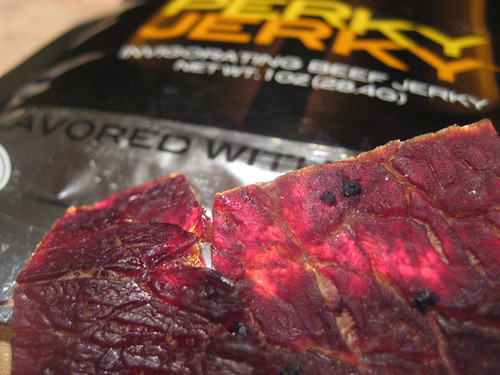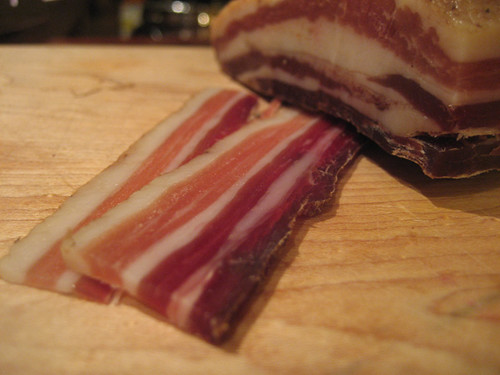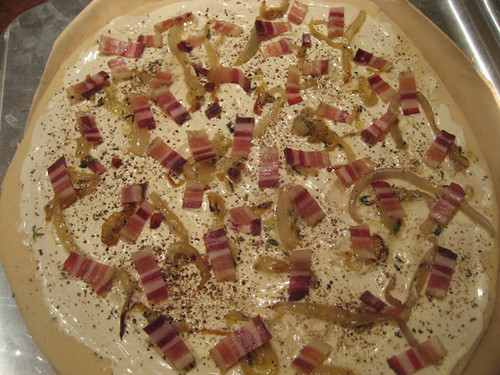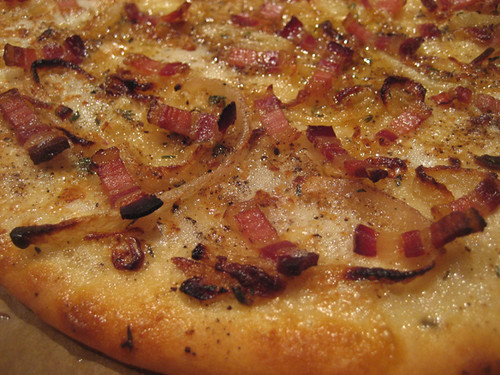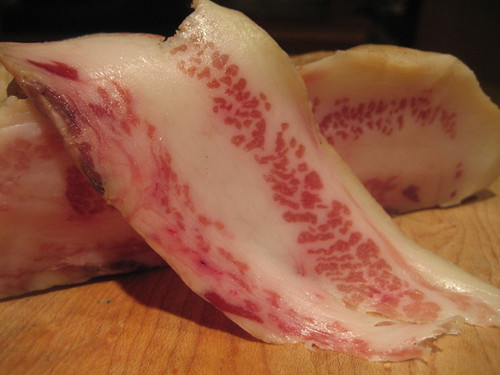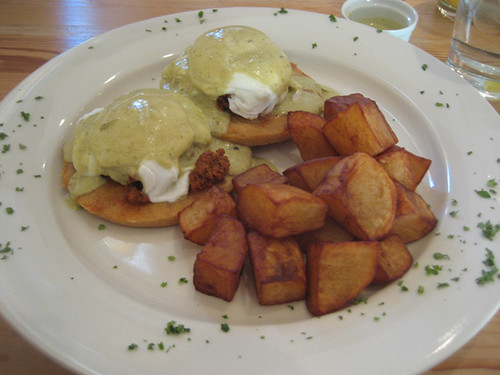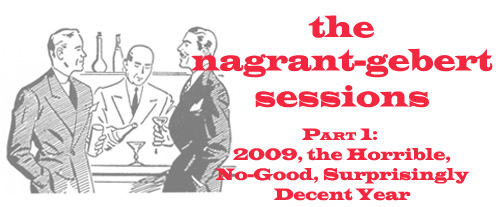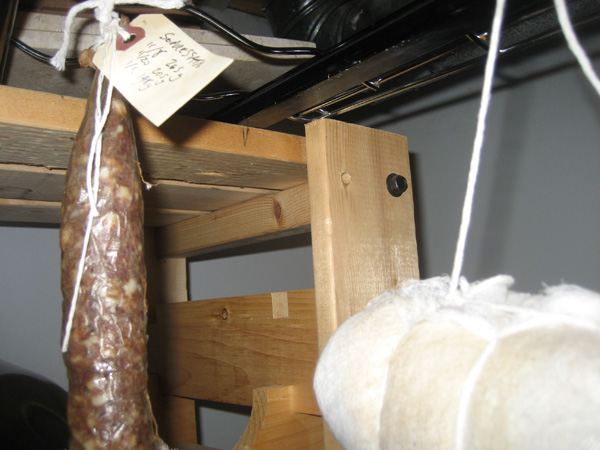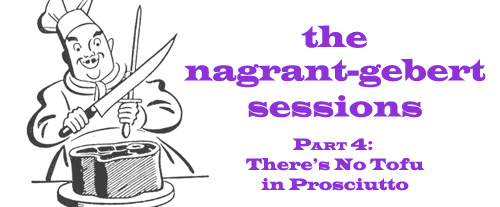
Our conversation (see parts one, two and three) turns to the ethical and legal dimensions of food:
MICHAEL GEBERT: So one of the things that happened in 2009 was, a young man named Jonathan Safran Foer discovered something called vegetarianism which none of the rest of us had ever heard of before, and promptly wrote a book to tell us heathens all about it. Now, I fully admit I haven’t read the book, my greatest exposure to Foer has come via an NPR piece, but my feeling based on how he came across there is, while it’s great that people are becoming more aware of how food actually gets made, and realizing that the comfy advertising picture of quaint farmerly bliss is a lie, I sense something essentially anti-food in the way Foer and others approach the topic— a Puritan revulsion against a culture of Costco-Walmart excess, like the way some environmentalism seems to be driven more by sophomoric reaction against suburbia and SUVs than by actual concern for the earth. And my problem with that is, if you can take away dinosaur-shaped chicken nuggets, you can take away what I want to eat, too.
I think there’s a potential war ahead between the Foers with their moral scolding and people like you and me who want to reform and improve the food system by supporting the things that taste better and, not coincidentally, are usually better for farmers and the environment too. So, are we the Cavaliers who must go to war against Foer’s Roundheads, or is this just a book-biz phenomenon rather than a food one?
MICHAEL NAGRANT: Not eating animals feels like the new Scientology, i.e. some seemingly incredible meaningful movement the wealthy, famous, and those with lots of free time can sink their teeth in to until they discover how empty the whole thing is. At the end of the day I’m mostly annoyed by those who feel they need to moralize and tell me what I should be doing, especially when what I do generally has no bearing on anyone else’s civil liberties.
Just this morning I read about the plaintiffs who are about to challenge Chicago’s handgun ownership laws in the Supreme Court. My knee jerk reaction, was, well, there’s a bunch of people I have no use for. After thinking about it for a few minutes though, while I believe none of us really should or need to be carrying around or filling our homes with handguns, I also fundamentally agree with what they are doing, i.e. fighting a system that’s telling them not to do something that inherently doesn’t hurt anyone (because as we know, guns don’t kill people. People kill people).
Of course you can go deeper and say that once one has a gun, they have the ability to take away someone’s most fundamental right, life. However, most of the people who want to bear arms desire to possess weaponry mostly because they’re sating a paranoia, engaging in sport, or at worst truly believing they’re acting as a deterrent against those who would infringe on their personal liberties. As a percentage, I think the number of gun owners who are looking to kill someone actively, even when attacked, and especially in an urban environment filled with educated folks, such as Chicago, is pretty low. In my world, I don’t have use for a gun, but I also don’t know if I have much use for those who say I can’t have one.
My attitude towards those who moralize and preach about vegetarianism is pretty much the same. You can be a vegetarian, but don’t insist that I be one as well. Of course, we have a bit more of a conundrum here in that, to eat meat is to inflict some measure of superiority or infringe on one’s liberty, and thus more challenging of my general life philosophy. I have no answer to the question of whether there’s a level of infringement that’s right or wrong or acceptable. Do animals even have civil liberties? Do plants have civil liberties? Do plants want to be eaten? Who’s to say chloryphyll and xylem and phloem aren’t just as precious as blood and flesh? In fact, one might argue they’re more important, for the exchange of carbon dioxide, oxygen, and nitrogen afforded by the plant cycle may be more important to the survival of earth than anything. Maybe we should be eating nothing.
Obviously that’s not the case. Survival of our species requires sustenance. I do have a curiosity and belief that our meat eating played a large role in our evolution i.e. the biological changes that occurred in our bodies, whether it’s improved musculoskeletal structure or the growth in the size of our brains. It’s tough for me to believe primordial man evolved to hunting and killing animals purely out of boredom, sport, and some idea of moral superiority, and not also out of a natural physical need. Then again it could be, no way to really tell.
That being said, basically along the way, we all make some choice about what we feel deserves to be eaten and what does not, and for every right reason we pursue that choice, there’s also generally some part of that choice fraught with some measure of poor logic, guilt, or other questionable external factor, even in the most committed of us. There are too many things we can not or do not know in the science or the spiritual balance of what we eat that no one can really definitively declare what’s right. However, and I know this is an assumption, but there’s a lot more allowable ambiguity to what and how we eat than there is for me in say allowing pedophilia.
The best thing we can do is be responsible and respectful in the choices we make. I certainly know where my food comes from, and I do believe that whatever I do eat has a right to a well-lived and well fed life before I may eat it. I also believe that if you’re willing to eat meat, you shouldn’t shirk the truth of what that means. I have no respect for meat eaters who say, I love meat, but I would never actually kill an animal. Those people are the first people that should be vegetarians if you ask me. Just as the vegetarians who pursue food that looks and tastes like meat, fake bacon and tempeh dogs or what have you, are still feeding the culture of meat-eating and thus should probably still be eating meat. I’ve killed birds and fish for a meal, and though I know it wouldn’t be easy, would be willing to do the same for any bigger animal that would be my dinner, because I understand the contract of what it means to eat meat. Because I understand that contract, and also because I value and appreciate the inherent taste of many vegetables and fruits, I tend to eat balanced meals and small portions of meat, sort of the Pollanesque ideal. If we have say steak or chicken on our plate, it’s usually like a 3 or 4 oz portion. Many nights we do not eat meat.
I’ve only read a small piece of the Foer stuff, so I’m not sure if he’s moralizing or advocating that we should all be vegetarians, or he’s just exploring his personal vegetarianism publicly, so it’s hard to comment specifically. However, it seems as if you say, his vegetarianism may be motivated or rooted in a cultural backlash of sorts. I know part of his motivation to explore the topic was to decide what he should be doing for his kids. As a father of a young child, while I want him to eat well, I intend to provide as wide a food picture as I can. I have a tough time thinking I should be the only arbiter or worse, an exclusionary force in what my son eats. I believe in giving him a cross-section and letting him decide to some extent, but then again maybe that’s because I believe meat eating is ok, especially done moderately.
Even then when I don’t love something, say what’s going on in big agriculture or commercial food culture, I still think it’s ok for my son to have a chicken nugget or a box of Kraft mac and cheese once in a while. The bulk of my food dollars will on balance go to buying locally produced and grown food, because I think that’s what tastes best and what supports the future world I want to live in, but I’m not the kind of person who’s likely to ever tell people they should be like me. I may however be ok telling the story of why I made the choices I did, and if that’s what Foer is doing, I’m ok with it.
What I think most important is eliminating the extremes. They generally are the most harmful. While I love small family farmed organic or sustainably farmed produce and animals, I’m not convinced it’s the future and smart model of agriculture, just as I think spraying and genetically modifying and threshing the hell out of everything isn’t either. To feed the world well, we will need a level of efficiency that I think will be a hybrid of the corporate and the individual models. I feel the same way about how we eat. We shouldn’t subsist on leaves alone, but we shouldn’t be out launching bazookas at herds of animals and killin’ em and grillin’ em while drooling near the campfire. Though it should be noted that I think Ted Nugent, who might be the poster child and the author of a cookbook called Kill Em and Grill Em, has thought deeply about what he does and respects animals more than your average vegetarian.
GEBERT: You know, at the risk of violating my own version of Godwin’s Law, which is that any productive discussion is over as soon as somebody brings Sarah Palin into it, one of the key food moments of the previous year, 2008, for me was the wave of revulsion that people had when they saw pictures of the governor of Alaska hunting moose in camo and eyeliner. So many of the comments revealed how clueless city folk are about life lived close to nature— it was obvious many people assumed that she would carve two steaks out of the moose and leave the rest of it to rot, unlike us civilized folk who buy our meat in styrofoam trays at the supermarket.
Of course, the exact opposite is true— people in Alaska who shoot a moose themselves will make 100 different meals out of it and not waste a thing; while all the bad things about eating meat come from those of us who live off the industrialized food system that turns animals into cannibals and pumps them full of antibiotics and makes them live in confinement and causes E. Coli outbreaks and, in this week’s ick story in the New York Times, built a business making hamburgers out of reprocessing the tiny bits of meat off fat scraps. So I think it’s good that Michael Pollan and others are educating us about how our food system really works and how our food gets made, with the intent of encouraging us to work toward a better system in which we eat less but better meat, for our own health and the health of the food system and the environment it affects.
The trouble is, Pollan’s a really good researcher and writer who knows there aren’t easy answers and that our food system represents a tremendous achievement in its own right, food so abundant that for the first time we have an obesity problem among the poor. He recognizes that it would be disastrous to shut it down; the question is how to evolve it toward being better, as we evolved automobiles from being gas-guzzling deathtraps to eco-cuddly hybrids, or popular music from Cole Porter to Lady Gaga. But then the subject gets taken up by other people who aren’t such good writers— they may be good stylists but they’re lazy, cheap thinkers. I ripped through Mark Bittman’s Pollan-ripoff book for that, and Foer too makes easy, overblown analogies— slavery, the Holocaust, eating dog— that seem designed to flatter the moral superiority of the reader rather than have anything to do with a realistic solution.
Much of this to me is just the latest chapter in the narcissism of Baby Boomers— if I buy frozen chicken nuggets I’m killing the planet, but if I buy organic free range chicken I’m saving it! This is simply a poor understanding of math as much as anything. If you buy or don’t buy chicken nuggets, your total effect on the 2009 U.S. consumption of chicken nuggets is a dot and a percentage symbol with a lot of zeroes in between them. You are a drop in an ocean of food. But if you buy a few free range chickens, your effect on Farmer Brown this week is substantially greater— a couple of percentage points of his take home pay for the week, potentially. So realistically, for right now, your power to do good is much greater than your power to do harm, and if you can shift a certain amount of your buying toward such purchases, you’re doing something virtuous. But obviously it’s a well-known psychological phenomenon that there’s secret satisfaction in beating yourself up for little sins, and that doing so is often, in fact, a form of pride— “I, the worst of all!”
And at that point, it’s not about food at all. It’s about moral poses, and that’s what worries me, because there’s no easier way to get government smack into the middle of everything, making moral choices for us. Now, like you, besides paying more for better meat, I am also trying to be a little more vegetarian here and there, and to eat less junk, and so on; and to teach my kids to do so. I joined a CSA this year to force myself to get more creative with vegetables, and I’ve been making vegetarian soup all year. Again, if I can make a net improvement in all that, great— but I’m not going to be consumed by guilt on the days it doesn’t happen. Partly because there’s simply no question that we evolved as omnivores, eating as much meat as we could get, and that it was hunting and a high-fat diet that gave us the brains we have today.
Ah, but we’ve used our technology to overcome many other savage habits, why shouldn’t eating animals be one of them? This is a hard thing to argue against— and it’s only going to get harder when lab-grown meat hits the market in the next few decades. If you think it was hard to make popular arguments for foie gras, just wait till you have to argue in a political forum why it’s more moral to raise and kill natural meat than to eat Insta-Beef™ from a factory, where no animals were harmed in the making of this pot roast. I believe something essential about our natures and about our connection to nature will be lost at that point, even moreso than it already is with today’s unnatural factory farming— but I also fully expect to be painted as a monster who wants Bambi to suffer and die for my sick gastronomic pleasures. I’ll be the equivalent of Nick Naylor in Thank You For Eating Meat.
To bring it back to the present day, we’re seeing a good example of how government can expand to crowd out our choices right now in the realm of charcuterie. I love the fact that there’s so much experimentation and interest in charcuterie and preserving on our restaurant scene. We could both name a lot of restaurants where that’s one of the real glories of the menu and a driving force of creativity in the kitchen. Yet as Heather Shouse’s terrific Time Out piece made clear, it all exists at the mercy of the health department which could kill it off in an instant. The barriers to entering the field are unnecessarily expensive and difficult, the usual old Chicago game of forcing you to spend a lot of money getting a piece of paper from somebody who’s well connected. And I know at least one old-school shop which is basically in the process of getting out of the housemade charcuterie biz because the health department just comes down harder every time they visit, they can see the writing on the wall.
Now, as small-L-libertarian as I am, meat inspection is one of those things I do actually think government should be doing. And those guys that Mike Sula wrote about with the bootleg charcuterie biz, they had to know they were asking to be shut down with that kind of publicity. But the problem is, it’s much easier for government to say no— either with an outright ban or by making the cost of meeting regulation too high for all but the well-connected big players— than to take the risk of allowing something. Too often, we are protected from the hypothetical small dangers, while the real dangers are big enough to be protected politically.
NAGRANT: The real problem I think is that there’s a real possibility that while Palin is out there shooting the Elk and throwing out her heirloom recipes for everything from silky Elk culatello to crispy elk ears to the press (which she obviously didn’t steal from Cindy McCain, I mean Gale Gand), when everyone goes home, she’s letting that stuff rot in the massively large deep freeze ice chest she bought with the tax rebate she paid herself and all Alaskans on behalf of the rediculously out of whack Federal subsidies Alaska receives annually.
Yeah, I also agree with you on the charcuterie thing. The nature of the cooking beast is that after a few chefs like say Adria or Achatz show how cool stabilizers or foams can be, a bunch of culinary school drop-outs start thinking they can be the next super molecular gastronomist, but they have no clue as to what they’re doing. And if they choose charcuterie as their weapon, well poorly cured meat is generally much more lethal than poorly aerated foam. Although, to be fair, you could probably make someone really sick if you served too much of some of the stabilizers out there. Which is interesting…that you don’t need any special license to wash food in sodium alginate or calcium chloride, or to mix transglutaminase in to everything, a practice which is a byproduct of the modern commercial food revolution, and yet everyone’s freaked out and licensing the hell out of a centuries old tradition with a pretty good track record of success. But, yes regulation has its place especially when the capacity to kill people exists. However legislative bodies as you point out would rather shut everything down than deal in nuance and exception. This of course is why Obama was so appealing. Here is the first man in a long time who seemed like he could be deliberative in his leadership approach. Maybe he should work on a national charcuterie initiative after the health care thing finishes up.
Also, minor issue, but I like Lady GaGa. I accept that she’s one big contrived mess, but she plots like no one else, and I believe her underlying talent is pretty real. She excites me in a early to mid career Prince and Madonna way. There are far more vapid hacks out there, Kid Sister I think being one of them. Everyone’s calling her album the dance pop album of the year, and maybe on paper it is, but I don’t think she can perform it live, and so for my money it’s GaGa all the way.
Lab cultured meat is certainly an interesting consideration. Harold McGee has been talking a lot about how the science says terroir in wines is a fallacy. While I think he’s on to something, I’d sure like for him to make a Clos du Mesnil style grand cru champagne in his lab for a couple of bucks and send it to me just to be sure. But that being said, I think there is a real case to made for terroir or the impact of environment on animals, maybe my most recent example being the acorn edition prosciuttio from La Quercia. The fat on that action really tastes like nuts, and I have a strong feeling it’s really all in accordance with the diet. Then again, I guess if we’re smart enough to culture meat, we’ll be smart enough to culture the enzyme that gives of hazelnut funk too.
GEBERT: I have no knowledge of the dark secrets of the Palin freezer, but in general, people in Alaska aren’t kidding about that stuff. I knew a guy in college who went off to be a newspaper editor in Bristol Bay, and during the two weeks the salmon run, everybody in town, newspaper editors and doctors and everybody (maybe not governors), goes to work canning fish. I always thought that was cool, that there was still a place that connected to its food source socially. One of my favorite recent food books, The Scavenger’s Guide to Haute Cuisine, which is about a guy who goes out to hunt and pick everything he needs for a 19th century dinner out of L’Escoffier, has an excellent chapter in Alaska that shows just how thrifty and ingenious they have to be to survive. I’d love to see those who hate hamburger culture turning to that level of low-impact food ingenuity rather than the future of industrial-sized veganism they imagine. Hell, I’d love to see a politician who actually made his own sausage, and not just as a metaphor for the legislative process.
Interesting point about the chemicals in trendy cooking. In general, charcuterie and preserving ought to be like anything else, a few good courses and we trust people not to kill us, I mean, a wrapped baked potato held for a few hours can breed Clostridium botulinum, there’s not something radically different about preserved foods that makes them a unique threat. I think it was Laurence Mate, who runs a legal charcuterie club downstate, who pointed out that plenty of people got meat-borne illnesses from lettuce last year, but not from restaurants making sopressata; the really scary thing is when corners get cut on an industrial level, and those guys won’t even close like a restaurant that sickened patrons would; they pay a fine and go right back to it, over and over.
TOMORROW: Gourmet, Twitter, Top Chef and all that jazz




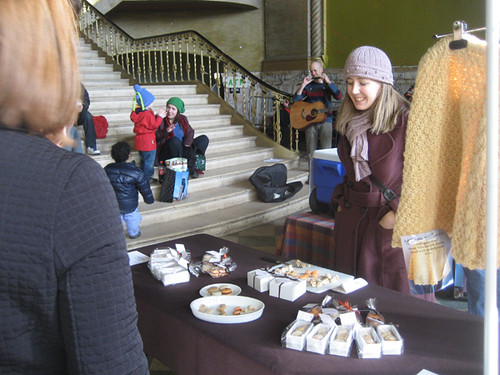
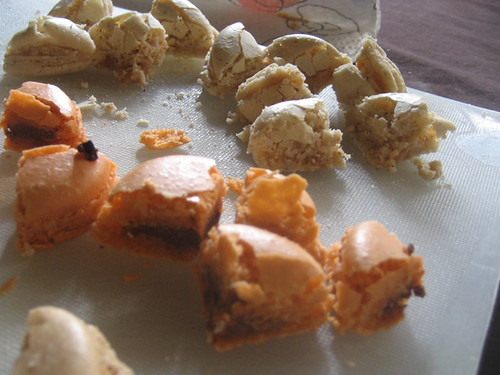


 Posted in
Posted in 

